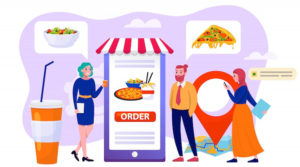In today’s fast-paced digital age, restaurants are continuously evolving to keep up with the changing landscape of consumer behavior. For local restaurants, establishing a strong online presence and attracting more customers to their physical locations are essential for sustained success. Innovative digital marketing strategies have become instrumental in achieving these goals in today’s digital age. By partnering with a digital marketing agency and leveraging the power of social media marketing, local restaurants can effectively boost their online visibility, engage with their target audience, and entice them to visit their establishments. In this article, we will explore the latest and unique digital strategies that local restaurants can employ to enhance their online presence and increase footfall.
Digital Strategies for Local Restaurants:

Search Engine Optimization (SEO):
Restaurants are realizing the immense potential of SEO to improve their visibility in search engine results. By partnering with a reputable SEO agency, they can optimize their website content, meta tags, and descriptions to rank higher in search engine rankings. Through keyword research, on-page optimization, and local SEO, restaurants can increase their organic traffic, attract local customers, and ultimately boost their business.
Moreover, online directories and review platforms play a vital role in attracting customers. By ensuring accurate and up-to-date information on platforms like Google My Business, Yelp, and TripAdvisor, restaurants can establish credibility and encourage positive customer reviews, which further contribute to higher search rankings.
Social Media Marketing:
In an era dominated by social media, restaurants are leveraging platforms like Facebook, Instagram, Twitter, and TikTok to connect with their target audience. By collaborating with a social media marketing agency, restaurants can develop engaging content, create brand awareness, and foster a loyal customer base.
Restaurants are harnessing the power of visually appealing food photography and videos to showcase their dishes, ambience, and unique offerings. Regularly posting high-quality content, running contests, and encouraging user-generated content help restaurants build an interactive online community, increase their following, and attract potential customers.
Influencer Marketing:
Influencer marketing has emerged as an influencial tool for restaurants to amplify their reach and tap into new customer segments. By collaborating with food bloggers, vloggers, and social media influencers, restaurants can leverage their large following and credibility to promote their brand and offerings.
Influencers sharing their experiences at a restaurant creates a ripple effect, generating buzz and curiosity among their followers. This strategy helps restaurants reach a wider audience and boosts their brand reputation and credibility.
Online Ordering and Delivery Services:
The rise of online food delivery services has transformed the restaurant industry, and establishments are leveraging these platforms to expand their customer base. Restaurants are partnering with popular delivery apps like Uber Eats, DoorDash, and Grubhub to offer convenient online ordering and delivery options.
Moreover, restaurants are optimizing their websites to provide seamless online ordering experiences. By integrating online reservation systems, customers can easily book tables and explore menus, enhancing the overall dining experience.
Email Marketing and Loyalty Programs:
Restaurants are utilizing email marketing campaigns to keep their customers engaged and informed about the latest offers, events, and promotions. By collecting customer data, restaurants can tailor personalized emails and offers based on individual preferences, driving customer loyalty and repeat visits.
Loyalty programs are also gaining traction as an effective strategy to retain customers. By offering exclusive discounts, rewards, and birthday incentives, restaurants can encourage customers to return and become brand advocates.
Latest Digital Marketing Trends for Restaurants:
Voice Search Optimization:
With the increasing popularity of voice assistants like Siri, Alexa, and Google Assistant, optimizing restaurant websites for voice search queries has become crucial. Restaurants are incorporating conversational keywords and long-tail phrases to cater to voice searches and capture potential customers.

Augmented Reality (AR) Menu Experiences:
Restaurants are adopting AR technology to enhance the dining experience. By allowing customers to virtually visualise dishes, explore ingredients, and read reviews, AR menus provide an interactive and engaging way to attract customers.

Social Listening and Online Reputation Management:
Restaurants are actively monitoring social media channels and review platforms to listen to customer feedback, address concerns, and manage their online reputation. Promptly responding to customer queries and reviews helps build trust and strengthen customer relationships.

Video Marketing:
The popularity of video content continues to rise, and restaurants are leveraging this trend by creating engaging and informative videos. Recipe tutorials, behind-the-scenes footage, and chef interviews entertain customers and showcase the restaurant’s expertise and authenticity.

Location-Based Mobile Advertising:
Local restaurants can leverage location-based mobile advertising to target potential customers in their vicinity. By teaming with a digital marketing agency that specializes in mobile advertising, restaurants can use geo-fencing and geo-targeting techniques to deliver personalized ads to smartphone users who are in close proximity to their establishment. These ads can feature enticing offers, daily specials, or upcoming events, encouraging users to visit the restaurant.

User-Generated Content Campaigns:
One of the most effective ways to showcase the authenticity and ambiance of a local restaurant is through user-generated content (UGC). Restaurants can encourage customers to share their dining experiences on social media using branded hashtags or by tagging the restaurant’s official account. By partnering with a social media marketing agency, restaurants can curate and feature UGC on their social media platforms, website, or even digital signage within the restaurant. UGC campaigns not only boost engagement but also serve as social proof, attracting new customers.

Virtual Tours and Interactive Experiences:
To provide potential customers with a virtual taste of their restaurant, local establishments can create immersive virtual tours and interactive experiences. By collaborating with a digital marketing agency specializing in interactive content, restaurants can offer 360-degree virtual tours, allowing users to explore the ambiance, decor, and seating arrangements. Additionally, interactive experiences like “build your own dish” or virtual wine tastings can be introduced to engage and excite potential customers, encouraging them to visit in person.
Local Influencer Partnerships:
Influencer marketing continues to be a high powered tool for local restaurants to expand their reach and tap into new customer segments. Collaborating with local influencers with a substantial community following can significantly impact footfall. A social media marketing agency can help identify and connect with relevant influencers such as food bloggers, local celebrities, or renowned chefs. These influencers can create engaging content, share their dining experiences, and promote the restaurant’s offerings, attracting followers and generating local community buzz.

Online Reservation Systems and Personalized Offers:
Implementing an online reservation system integrated into the restaurant’s website or mobile app can streamline the booking process and enhance customer convenience. By partnering with a digital marketing agency, restaurants can also leverage customer data collected through reservations to personalize offers and promotions. Tailoring special deals, exclusive discounts, or personalized birthday incentives can entice customers to choose their restaurant over competitors, ultimately driving footfall.

Micro-Targeted Social Media Advertising:
To reach a highly targeted audience, local restaurants can utilize micro-targeted social media advertising campaigns. By partnering with a social media marketing agency, restaurants can identify specific demographics, interests, and behaviors of their ideal customers. Ads can be tailored to resonate with these specific audiences, showcasing the restaurant’s unique offerings, special menus, or limited-time promotions. Micro-targeting maximizes the impact of advertising budgets by reaching those who are most likely to visit the restaurant.

Collaborations with Delivery and Food Aggregator Platforms:
To cater to the rise in demand for food delivery, local restaurants can collaborate with popular delivery and food aggregator platforms like Uber Eats, DoorDash, or Grubhub. By optimizing their menu listings on these platforms and offering exclusive discounts or promotions for online orders, restaurants can tap into a wider customer base, driving both online orders and footfall from satisfied customers who experience their cuisine at home.

Conclusion
Incorporating innovative digital marketing strategies is vital for local restaurants to thrive in today’s competitive landscape. By partnering with a digital marketing agency and harnessing the power of social media marketing, location-based advertising, user-generated content, and personalized offers, local restaurants can significantly boost their online presence, engage with their target audience, and attract more footfall to their establishments. Embracing these unique strategies will not only drive customer traffic but also foster a loyal customer base and contribute to long-term success in the digital era.



















